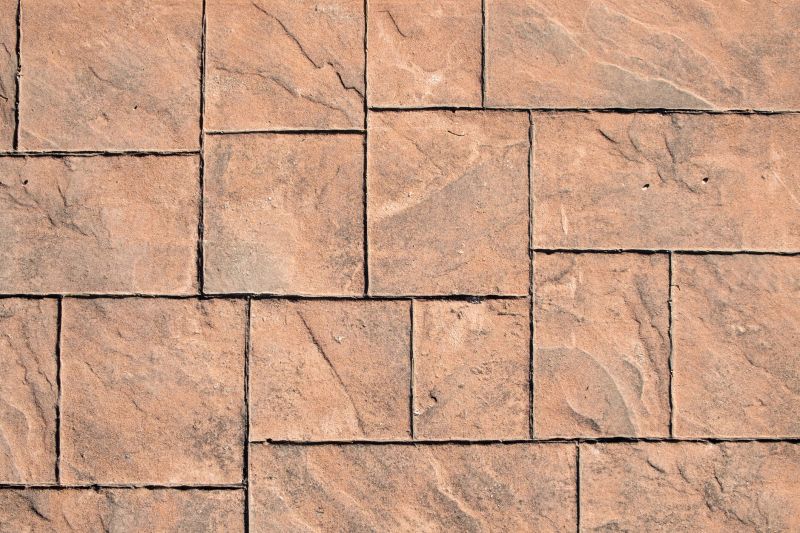Top-Rated Products For Stamped Concrete Service Applications
Browse a selection of high-performance products that ensure professional finishes and long-lasting results.
 Stamped concrete is a popular choice for enhancing the aesthetic appeal of outdoor surfaces such as patios, walkways, driveways, and pool decks. This decorative technique involves imprinting patterns onto freshly poured concrete, creating the appearance of stone, brick, slate, or other textured surfaces. To achieve durable and visually appealing results, a variety of specialized products are used throughout the stamping process, from surface preparation to finishing touches. High-quality tools and materials can help ensure consistent pattern replication, proper sealing, and long-lasting color retention.
Stamped concrete is a popular choice for enhancing the aesthetic appeal of outdoor surfaces such as patios, walkways, driveways, and pool decks. This decorative technique involves imprinting patterns onto freshly poured concrete, creating the appearance of stone, brick, slate, or other textured surfaces. To achieve durable and visually appealing results, a variety of specialized products are used throughout the stamping process, from surface preparation to finishing touches. High-quality tools and materials can help ensure consistent pattern replication, proper sealing, and long-lasting color retention.
Top Overall Option
Comprehensive Stamped Concrete Kit
A complete kit that includes a variety of release agents, colorants, sealers, and application tools designed to streamline the stamping process. Ideal for both DIY projects and professional contractors seeking reliable, consistent results with versatile product options.
Types of Products For Stamped Concrete Service
Release Agents
Products used to prevent sticking and define patterns during stamping, available in various formulations for different surface conditions.
Color Hardener
Powdered coloring agents applied to concrete surface to add vibrancy and mimic natural stone or brick textures.
Liquid Color Stains
Liquid dyes used to add depth and variation to the surface, enhancing the stamped pattern's realism.
Integral Color
Color mixed directly into the concrete before pouring for uniform coloration throughout the surface.
Sealants
Protective coatings that seal in color and pattern, providing resistance against weather, stains, and wear.
Acid Stains
Chemical-based stains that produce variegated, natural-looking color variations on concrete surfaces.
Pattern Mats
Silicone or rubber mats used to imprint specific textures and designs onto the stamped concrete.
Jointing Tools
Tools to create control joints and enhance the pattern's appearance and functionality.
Surface Cleaners
Products designed to prepare and clean the surface before stamping or sealing.
Texture Rollers
Tools used to add additional textures or patterns to the concrete surface for a customized look.
Color Release Agents
Specialized release products that add color contrast and enhance pattern definition during stamping.
Glow-in-the-Dark Additives
Materials that can be incorporated into sealers or overlays to add illumination at night.
Overlay Products
Thin decorative overlays used to restore or enhance existing concrete surfaces with stamped patterns.
Anti-slip Additives
Materials mixed into sealers to improve traction and safety on stamped concrete surfaces.
Popular Choices
Widely used for their versatility in different stamping applications and pattern types.
Popular for adding vibrant, durable color to stamped concrete projects with easy application.
Chosen for their durability and clarity, helping to preserve the surface and pattern details.
Commonly used for creating realistic textures and intricate designs on concrete surfaces.
Favored for their ability to produce subtle color variations and enhance stamped patterns.
Essential for creating clean control joints and defining the pattern layout.
Popular for preparing surfaces to ensure proper adhesion and pattern clarity.
Increasingly used for restoring or upgrading existing stamped concrete surfaces.
Trending for nighttime aesthetics and safety features in stamped concrete designs.
Often selected to improve safety on outdoor stamped surfaces exposed to weather and moisture.
In Littleton, Colorado, many contractors and DIY enthusiasts rely on a comprehensive selection of products designed specifically for stamped concrete projects. These include release agents that prevent sticking and enhance pattern definition, coloring agents to add vibrancy and depth, and sealers that protect against weathering and wear. Proper application of these products is essential for achieving a professional-looking finish that withstands foot traffic, UV exposure, and temperature fluctuations.
Choosing the right products depends on several factors, including the type of pattern desired, the existing surface conditions, and the environmental considerations of the project location. Whether you are working on a small residential patio or a large commercial space, selecting compatible products and tools can make a significant difference in the final outcome. It is advisable to select products that are easy to apply, offer good coverage, and provide reliable results over time.
In Littleton, CO, where the climate can vary, investing in high-quality sealers and colorants can help maintain the integrity and appearance of stamped concrete surfaces. Proper maintenance with suitable cleaning and sealing products can extend the lifespan and preserve the visual appeal of the decorative concrete. Always follow manufacturer instructions and consider consulting with local professionals for recommendations tailored to Colorado’s specific environmental conditions.
Key Buying Considerations
- Compatibility with existing concrete surfaces and project requirements.
- Type of pattern or texture desired and the corresponding pattern mats or stamps.
- Durability and weather resistance of sealers and protective coatings.
- Ease of application and drying time for each product.
- Color stability and fading resistance over time.
- Environmental conditions of the project site, including temperature and humidity levels.
- Level of surface preparation required before applying products.
- Safety features such as anti-slip additives or slip-resistant sealers.
- Coverage area per unit to estimate quantities needed accurately.
- Compatibility of colors and release agents to prevent unwanted reactions.
- Ease of cleaning and maintenance after application.
- Product shelf life and storage conditions.
- Cost-effectiveness relative to project scale and desired finish.
- Availability of professional support or technical assistance from suppliers.
- Compliance with local building codes and standards.
